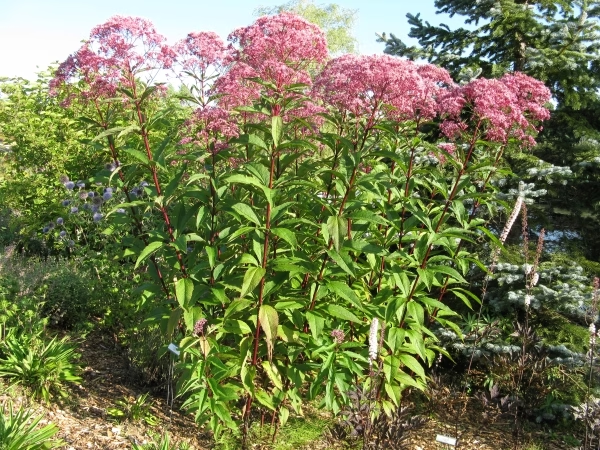
Joe Pye Weed
Botanical Name
:
Eupatorium maculatum
Plant Type
:
Perennial, wildflower
Seasons
:
Plant in the spring after the last frost; blooms from mid-summer to fall
Sun Level
:
Full sun (at least 6 hours of daily sunlight) to partial shade; too much shade can cause legginess and flopping; appreciates some protection from the hot afternoon sun, especially in summer
Ideal Soil Temperature for Planting
:
50–70°F (10–21°C)
Soil Type
:
Prefers fertile, well-drained soil
Hardiness Zones
:
3–9 (USDA)
Germination
:
2–3 weeks; requires stratification for about ten days at 40°F (4°C)
P.H. Level
:
Tolerates nearly all soil pH levels
Water/Irrigation
:
Keep soil evenly moist in the first growing season but not soggy; mature plants have some tolerance for short periods of drought; water about an inch per week if it has not rained
Fertilization
:
Usually not needed in fertile soil; for poor soil, apply a slow-release granule fertilizer in spring when new growth begins and again in midsummer when blooms appear; mixing compost into the soil in spring is beneficial
Habit
:
Clumping, upright, and sturdy growing habit
Propagation
:
Seeds, division, and root cuttings
Final Plant Height
:
5–8 ft
Spread
:
4–5 ft
Flowers
:
Mauve or pink-purple flowers blooming in large clusters atop tall, thick stems
Attracts
:
Bees, birds, butterflies
Uses
:
Good choice for planting in rain gardens and for landscaping
Companions
:
Asclepias incarnata (swamp milkweed), aster (aster), Coreopsis triperis ‘Gold Standard’, Echinacea (coneflower), Monarda (beebalm), Phlox paniculata (garden phlox), and Physostegia (obedient plant)
Pruning
:
Cut back dead stems in late fall or leave them for winter interest. Pinch back early for a shorter, bushier plant with more flowers. Deadhead blooms to control spreading
Toxicity
:
Non-toxic to humans and pets
Pests
:
Aphids, treehoppers, leaf beetles, and leaf miner flies
Diseases
:
Powdery mildew
Fun Fact
:
It’s named after Joseph Shauquethqueat, a Mohican sachem (paramount chief) and herbalist known to his white neighbors as Joe Pye, who lived in the Mohican community of Stockbridge, Massachusetts, during the late 1700s to early 1800s
Botanical Name
:
Eupatorium maculatum
Plant Type
:
Perennial, wildflower
Seasons
:
Plant in the spring after the last frost; blooms from mid-summer to fall
Sun Level
:
Full sun (at least 6 hours of daily sunlight) to partial shade; too much shade can cause legginess and flopping; appreciates some protection from the hot afternoon sun, especially in summer
Ideal Soil Temperature for Planting
:
50–70°F (10–21°C)
Soil Type
:
Prefers fertile, well-drained soil
Hardiness Zones
:
3–9 (USDA)
Germination
:
2–3 weeks; requires stratification for about ten days at 40°F (4°C)
P.H. Level
:
Tolerates nearly all soil pH levels
Water/Irrigation
:
Keep soil evenly moist in the first growing season but not soggy; mature plants have some tolerance for short periods of drought; water about an inch per week if it has not rained
Fertilization
:
Usually not needed in fertile soil; for poor soil, apply a slow-release granule fertilizer in spring when new growth begins and again in midsummer when blooms appear; mixing compost into the soil in spring is beneficial
Habit
:
Clumping, upright, and sturdy growing habit
Propagation
:
Seeds, division, and root cuttings
Final Plant Height
:
5–8 ft
Spread
:
4–5 ft
Flowers
:
Mauve or pink-purple flowers blooming in large clusters atop tall, thick stems
Attracts
:
Bees, birds, butterflies
Uses
:
Good choice for planting in rain gardens and for landscaping
Companions
:
Asclepias incarnata (swamp milkweed), aster (aster), Coreopsis triperis ‘Gold Standard’, Echinacea (coneflower), Monarda (beebalm), Phlox paniculata (garden phlox), and Physostegia (obedient plant)
Pruning
:
Cut back dead stems in late fall or leave them for winter interest. Pinch back early for a shorter, bushier plant with more flowers. Deadhead blooms to control spreading
Toxicity
:
Non-toxic to humans and pets
Pests
:
Aphids, treehoppers, leaf beetles, and leaf miner flies
Diseases
:
Powdery mildew
Fun Fact
:
It’s named after Joseph Shauquethqueat, a Mohican sachem (paramount chief) and herbalist known to his white neighbors as Joe Pye, who lived in the Mohican community of Stockbridge, Massachusetts, during the late 1700s to early 1800s
Written by Nondiah Khalayi – https://www.linkedin.com/in/nondiah-khalayi/

